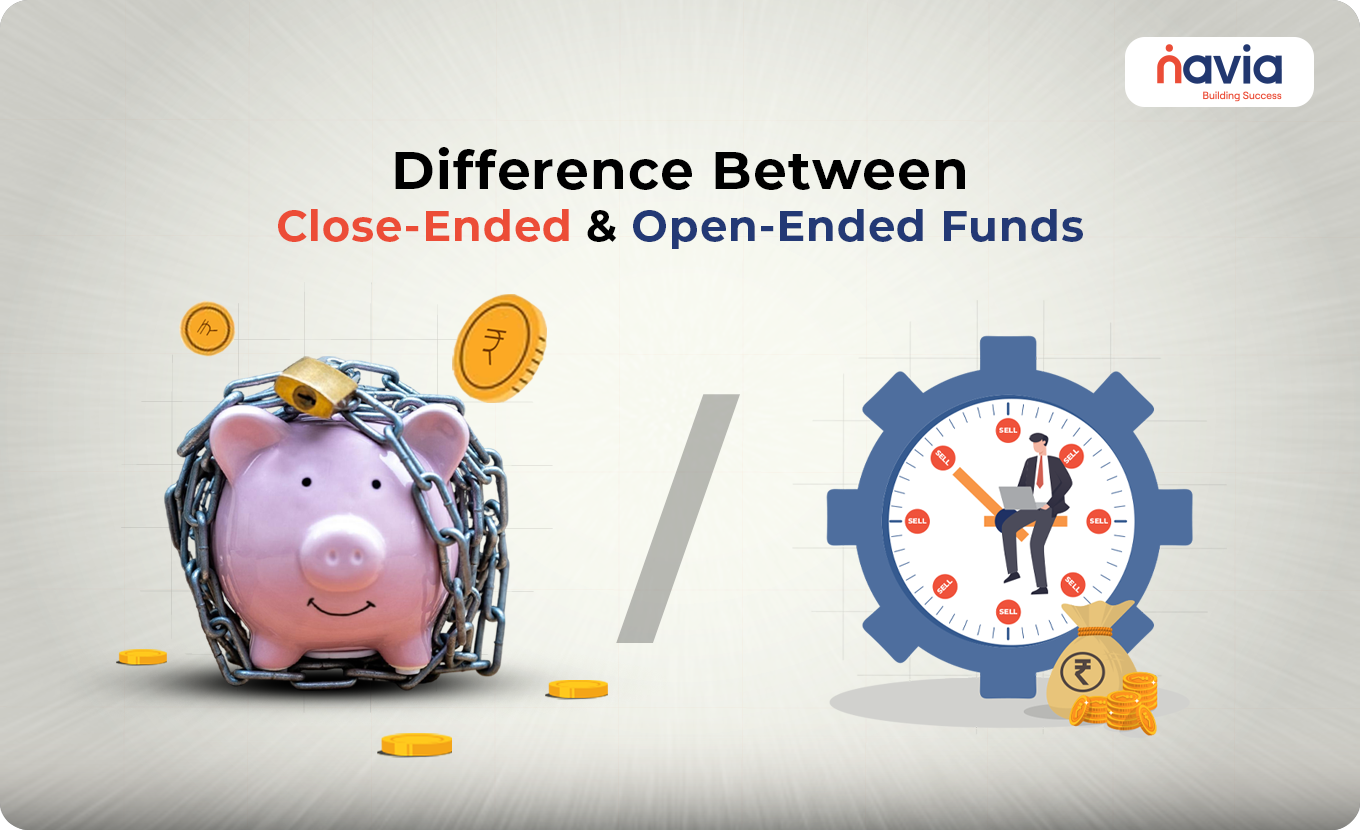Difference Between Close-Ended and Open-Ended Funds

We know that mutual funds are the best investment option for investors who are seeking diversification, professional management, and easy access to returns. When talking about its structure, mutual funds are classified into two categories, open-ended and close-ended funds.
It is important to understand the difference between close-ended and open-ended funds before you make investment decisions. In this blog we explore both fund types, their advantages and disadvantages, and how they differ from each other in detail.
What are Open-Ended Mutual Funds?
Open-ended mutual funds are one of the schemes of mutual funds that allow investors to enter or exit from the fund at any time. It doesn’t have fixed maturity periods, and the unit prices are based on the daily NAV (Net Asset Value).
The term is very simple; if you are choosing an open-ended fund, you can easily enter or exit from the fund anytime. One of the most popular investment plans, SIP (Systematic Investment Plans), is offered under open-ended schemes.
Pros and Cons of Open-Ended Funds
| Pros | Cons |
| Enter or exit anytime | The value of funds will change depending on the market conditions. |
| Daily NAV (Net Asset Value) disclosure will help to easily track fund value | Some funds ask charges for early withdrawals |
| Small investment spread across various securities | Frequent buying and selling processes will lead to transaction costs |
| Systematic Investment Plans (SIP) are available for this fund | Returns are not guaranteed |
What are Close-Ended Mutual Funds?
Close-ended mutual funds have a fixed maturity period; it is usually 3 to 5 years, and it’s open for subscription only during the NFO (New Fund Offering) period. If the NFO period is over, the fund didn’t accept any new investment, and the investors cannot redeem units directly.
To offer liquidity to the investors, closed-ended funds are listed on stock exchanges that will help them to trade units like stock.
Pros and Cons of Close-Ended Funds
| Pros | Cons |
| Fund managers can execute long-term strategies | Investors can’t redeem their units until maturity period ends |
| Prevent impulsive decisions | Only lump sum option |
| Fund managers can deploy strategies to get better returns | Close-ended funds didn’t offer the data to analyze the performance with different market situations |
| Selling on the stock exchange at prices that are determined by the demand and units of the scheme | If liquidity is low, challenges will arise while selling units. |

Difference between Close End Funds and Open-End Funds
The difference between close-ended and open-ended mutual funds can help you choose the right one for your investment strategy.
| Feature | Open-Ended Funds | Close-Ended Funds |
| Subscription Period | Any time after launch | Only during NFO |
| Liquidity | High and investors can redeem anytime | Limited and investors must wait or sell on exchange |
| NAV Pricing | Based on daily NAV | Trades on exchange price (may differ from NAV) |
| Investment Mode | SIP & lump sum available | Only lump sum investment |
| Fund Size | Changes with inflow/outflow | Fixed |
| Lock-in Period | No lock-in | Locked till maturity |
| Portfolio Management | May change due to frequent redemptions | Stable and long-term approach |
| Suitability Mismatch | Not ideal for investors who have long-term vision | Not ideal for investors who need flexibility, or cash flow access |
| Reach & Distribution | Readily available through online platforms | Limited visibility post-NFO |
| Analysis | Analyse and compare similar schemes easily | Analyse and comparison not possible |
Wrap Up
Both close-ended and open-ended mutual funds have their unique advantages and disadvantages. So, we won’t be able to tell if one is better than another. Open-ended funds are suitable for investors who are seeking liquidity and flexibility, while close-ended funds are fit for investors who can stay invested for the entire maturity period.
If you want to choose the best one for your financial goals, you must analyze your goals, investment horizon, and mainly your risk tolerance. So, are you ready to balance your portfolio by including better funds? Join Navia Markets and see the changes now!
Do You Find This Interesting?
Frequently Asked Questions
What is the main difference between close-end and open-end funds?
Open-end funds allow continuous buying/selling, while closed-end funds are locked in after the NFO and trade on stock exchanges.
Can I invest in a close-ended fund after the NFO?
No, investment is allowed only during the NFO period.
Which is more liquid, closed or open-ended mutual funds?
Open-ended mutual funds offer more liquidity as units can be redeemed with the fund house anytime.
Are close-ended mutual funds riskier than open-ended ones?
Both carry market risks. However, closed-end funds may have additional liquidity and pricing risk due to exchange trading.
Do open-ended funds offer better returns?
Returns depend on fund performance and market conditions, and open-ended funds offer flexibility, but returns are not guaranteed.
Can I do SIP in close-ended mutual funds?
No, SIP is generally not available in close-ended funds.
How are open and close-ended mutual funds taxed?
Taxation depends on the asset type; equity-oriented funds have different tax treatments than debt funds.
DISCLAIMER: Investments in the securities market are subject to market risks, read all the related documents carefully before investing. The securities quoted are exemplary and are not recommendatory. Brokerage will not exceed the SEBI prescribed limit.






